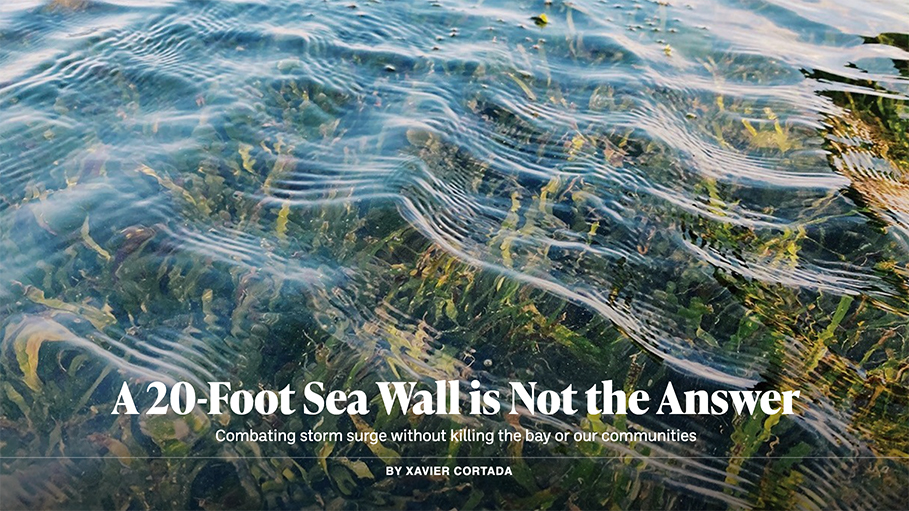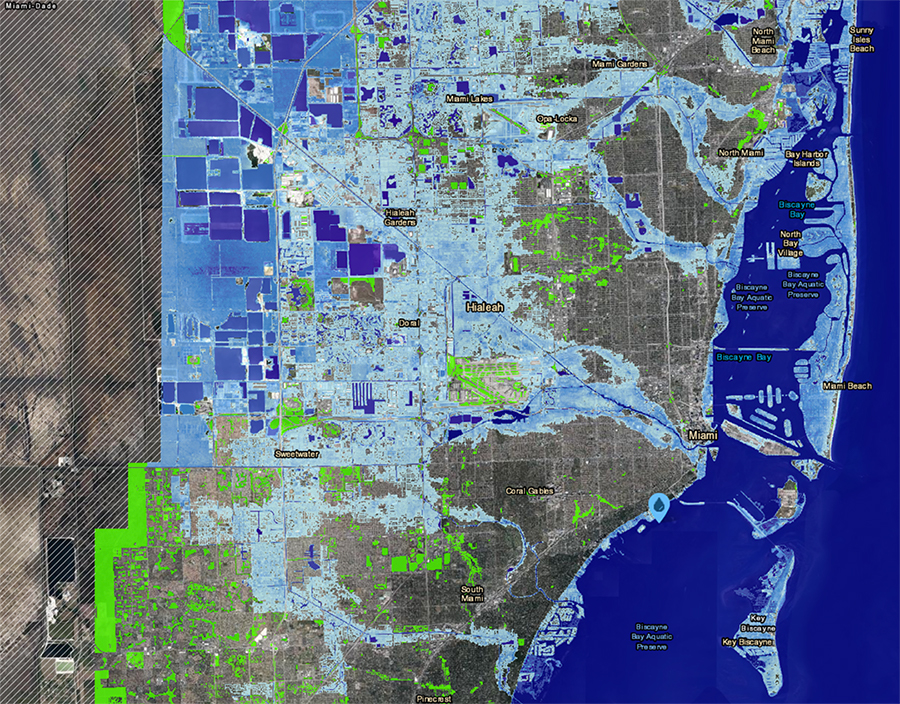

BY XAVIER CORTADA (Biscayne Times, July 2021) – Concerned about the human impact on the health of Biscayne Bay, in 2014, as part of my 50th birthday celebration, I launched the Seahorse Society. This participatory eco-art project asked citizens to care for our bay and its sea grasses, home to the charismatic seahorse. I had participants draw a seahorse on a flag and pledge to do something (an eco-action) to protect a bay degraded by pollution, run-off and propeller scars.

Here are some eco-action pledges:
I will use less or no fertilizer on my lawn.
I will pick up trash, even if it isn’t mine.
I will use nontoxic pesticides and household products.
I will conserve water with shorter showers.
I will urge my politicians to protect Biscayne Bay.
This last one is really important right about now, as local politicians are seriously considering whether or not to give our bay the kind of sea grass scarring 100,000 propellers wouldn’t even be able to do.
Building a 20-foot wall across Biscayne Bay would cause irreparable harm to a body of water already teetering on survival. The collapse of sea grass communities in north Biscayne Bay, which began in 2013, and the large-scale fish mortality events that occurred in the summer of 2020 clearly demonstrate the sensitivity of the ecosystem.
The disruption caused by building a concrete wall, coupled with it being polluted by nutrient sources from the watershed, could be the final straw that ushers in a permanent regime change from sea grasses to persistent algae blooms. We are talking about ecosystem collapse here!
How much is your waterfront condo going to be worth when the water, devoid of oxygen, looks like pea soup and smells like death? How will your business thrive when tourists and their dollars stop visiting you?

And to what end will building this wall take us? We’re not saving properties here. No matter how tall we build the wall, the water will rise through the oolite limestone beneath our feet. Spending all of that money ($4.6 billion) to kill our bay will ultimately still leave us vulnerable to sea-level rise. The wall will only address storm surge, and only on the northwest coast of the bay.
Forget the wall.
Let’s instead spend our money and efforts on finding climate solutions that are equitable, responsive and forward-thinking.
Desperate times call for desperate measures and, smack dab in the middle of an existential crisis, these are desperate times. When the waters rise and do not recede, living shorelines (mangroves, mangroves and more mangroves) and yes, eventually, managed retreat, will prove to be the better options.
Unfortunately, few want to accept this reality. Few believe we live in a climate emergency. Few get the climate science. Few understand the trouble we are in.
Today in Miami and other coastal cities, construction cranes populate the skyline, building more and more skyscrapers at the water’s edge. Growth is what fuels our economy. Increased development grows the tax base and keeps property taxes from rising.
Developers push for growth. It’s a high reward game with little actual risk: They get their return on investment when their condos get sold.
Buyers, mostly international cash investors, are also hedging their bets, hoping to flip affluent properties a few years later and way before the psychology of sea-level rise bursts the real estate bubble.
Homeowners in less affluent areas are on a 30-year timeline. Because of brazen overdevelopment, citizens don’t have a real sense that sea-level rise poses a true threat to their homes, savings, jobs and community.
Politicians, who are evaluated in two- and four-year election cycles, have no incentive to plan for the long term. They engage in new-build ribbon-cutting ceremonies with impunity, even if that will only burden future generations. Their pro-growth actions signal to constituents that everything will be fine, but all they are doing is kicking the can down the road.
As oceans rise and the reality of climate change finds clarity in the psychology of Miami’s real estate markets and tourism economy, many marginalized members residents are going to suffer far more than those who have power and means.
Sea-level rise will affect us all, but it will disproportionately impact people of color and poorer residents in low-elevation areas. As low-income neighborhoods are abandoned, property owners will lose everything. It will disproportionately impact people of color and poorer residents who rent in higher-lying low-income neighborhoods. Evicted renters are often the first and primary victims of climate gentrification.
The proposed wall project does not at all appear to consider its own social and cultural consequences. In particular, it ignores how the interconnectedness of our communities does not allow for the implementation of solutions in one area without other areas being affected. While there is a concentration of buildings and social vulnerability in the area north of the Rickenbacker Causeway, the southern half of the county has been almost completely ignored in the analysis.
In a county where everything is interconnected, everything and everyone matters. Inequitable spending of tax dollars to protect wealthy homes at the water’s edge without protecting other impacted neighborhoods guarantees that the tax base will erode, just as it is needed to address the wicked problems rising seas will bring.
We must plan smarter.
We must uplift and amplify all voices in the pursuit of social and economic stability for all Miamians. But before we can change society, we must change ourselves, believe in our ability and strengthen our resolve. We need to better understand our bay, our ecosystems, climate science, and what’s at stake for us and those who will follow.
Cortada-headshot-2 (2).png(Courtesy of Xavier Cortada)
Xavier Cortada
We must, all of us, work together and learn together to find equitable solutions for a future with rising seas. We must do so without imperiling our bay and its ecosystem services.
We can begin by pledging these three Seahorse Society eco-actions:
I will commit to learning more about marine ecosystems.
I will teach my friends & family about Biscayne Bay.
I will urge my politicians to protect Biscayne Bay.
Xavier Cortada is an artist, professor of practice at the University of Miami Department of Art and Art History, and artist-in-residence at Pinecrest Gardens, where his studio, gallery and socially engaged art practice are based. Using art’s elasticity to engage others, Cortada educates and inspires others to work and learn together to solve our community’s collective issues.
LINK TO ORIGINAL ARTICLE: https://www.biscaynetimes.com/viewpoint/a-20-foot-sea-wall-is-not-the-answer/